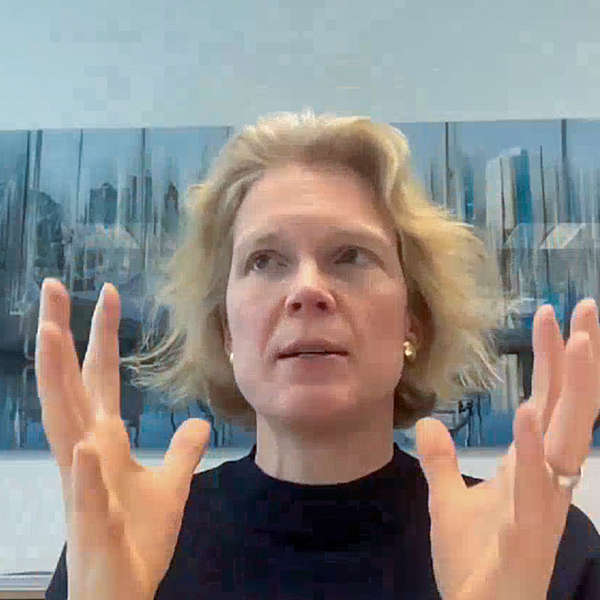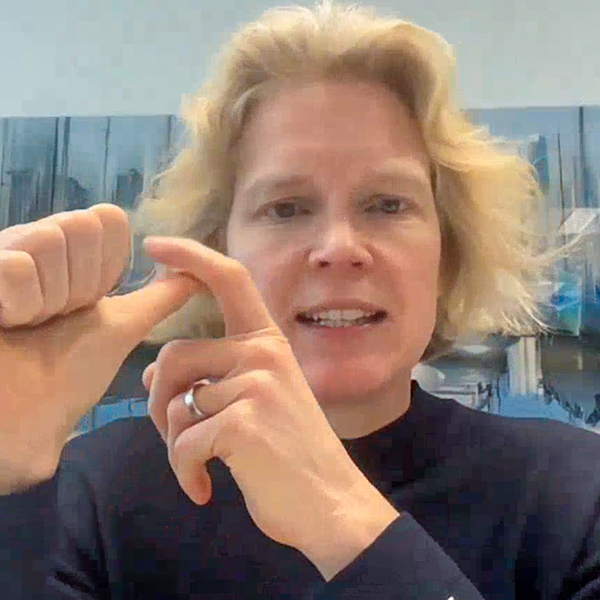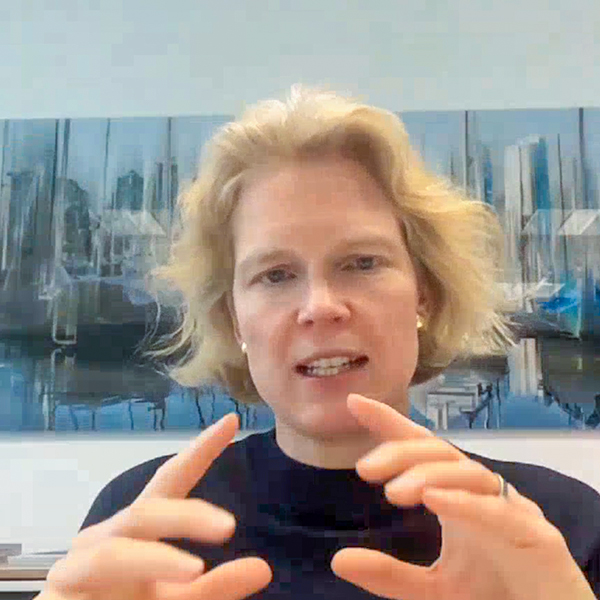
|
The Industrial Metaverse links the real and virtual WorldsAn Interview with Prof. Dr. Katharina Hölzle According to analyses, the metaverse and the industrial metaverse in particular offer incredible potential for growth. In an interview with the PROSTEP Newsletter, Prof. Dr. Katharina Hölzle from Fraunhofer IAO discusses what this means and how German companies can benefit. Hölzle was responsible for the CyberLänd project, which aimed to explore the potential that the metaverse offered the German land of Baden-Württemberg. 
Question: Professor Hölzle, what is your understanding of the terms metaverse and industrial metaverse? Hölzle: To me, the metaverse means linking the virtual and real worlds and, when we talk about the industrial metaverse, the interaction between what are referred to as extended/virtual reality technologies and other hardware and software technologies. I would therefore see the whole thing as more of a generic term for a system of different enabling technologies. Question: The metaverse is not the first attempt to create a virtual world. What makes it different from Second Life, for example? Hölzle: For me, the first difference is the fact that the metaverse and the industrial metaverse in particular are not completely virtual and instead always function in conjunction with the real world. I move around in the real world with my VR glasses on or sensors attached to my body, i.e. I'm in an environment that is equipped with technology that extends into virtual space. The second difference is the different technologies, which were not as advanced back then as they are now. Second Life mirrored our real world and we as humans could immerse ourselves in this virtual world and buy goods, land or art. But that is only one part of the metaverse and actually has nothing to do with the industrial metaverse. The industrial metaverse is all about digital twins, digital production and interaction between different product data systems and platforms. Question: A distinction is usually made between the consumer metaverse, the commercial metaverse and the industrial metaverse. Which one offers the greatest potential for growth? Hölzle: Experts have yet to agree on an answer. The growth forecasts for all three sectors range between 180 billion dollars and 5 trillion US dollars – there is a lot of imagination at work here. I see the industrial metaverse as offering the greatest potential due to the wide range of possible applications in the context of B2B. It's not yet entirely clear what the underlying business model in the consumer sector would look like. That's why I'm cautious in my assessment of its potential. Question: You've written an article together with other authors on the potential of the metaverse in the context of developing smart services. Is this where you see the greatest potential? Hölzle: I need to go into a bit more detail here. The industrial metaverse is a system of systems that links different technologies. But there is also the topic of product-service systems and services for production systems, because we know that the physical product is only one part of the topics relating to the data economy, digitalization and digital business models. Smart services are an important part in the context of the metaverse, especially when giving thought to new business models. In the future, a great many things will be offered in digital form in the metaverse, which leaves room to discuss whether we are still talking about a product or a service. In this respect, the combination of smart services with products and production is a result of the industrial metaverse. Question: Isn't the industrial metaverse merely old wine in new bottles? Virtual models and immersive technologies have been used in product development for years? Hölzle: That's exactly what we say to companies, because they often don't know what the metaverse is and are afraid that they won't be able to master it. That's why we pointed out in our CyberLänd study that much of what constitutes the industrial metaverse actually already exists. We do however still see many system discontinuities between product development systems, product data management systems and PLM systems, although attempts are now being made to consolidate these systems using platforms like Manufacturing-X. The vision being that the industrial metaverse will make this seamless integration possible and that we'll have a uniform data model and uniform data standards on these platforms that can be used by the individual systems. Question: Does this mean that initiatives like Gaia-X and Manufacturing-X can be a great help when it comes to the industrial metaverse? Hölzle: Yes. It's very important to me that we create European standards and reach European agreements in this context, but we all know that Gaia-X has yet to prove itself a successful model. Question: 3D models are a key prerequisite for the metaverse. However, 3D models of production systems often don't exist or are not up to date? Hölzle: That is of course a fundamental problem because without these models there's no point in even thinking about virtual collaboration. But we have to start somewhere. I hope that when we develop something new or purchase new machines that we also give thought to the digital twin from the very start. When it comes to existing systems, we're faced with the challenge of how to digitalize them. We currently lack easy-to-use tools that would make it possible to create these twins quickly and with a minimum of effort. Not only the government and but also companies need to invest more money in research. 
Question: Approaches like the one developed the DigiTwin joint project, in which PROSTEP turned 3D point clouds of systems into digital twins with the help of artificial intelligence, already exist. What do you think? Hölzle: Yes. The increasing use of AI means that we no longer need to collect every last piece of data in order to build this type of twin because interpolation can make us faster. Question: Where does the focus of the CyberLänd project, which you implemented together with Fraunhofer IPA and the Virtual Dimension Center, lie? Hölzle: To begin with, we wanted to find out where we stand with regard to this topic here in Baden-Württemberg, i.e. create a map indicating that a lot has already been achieved. The industrial metaverse exists, even if it is not yet complete. It is not yet the whole system of systems, but we have numerous different technologies and subsystems that are being developed or used here in Baden-Württemberg. It was important to us that we demonstrate this and also indicate who the players are – they are not only manufacturing companies but also creative companies, service providers and scientific institutions. The aim was to make this clear and establish networks. We still offer virtual meetings that bring the players together and provide input by way of concrete use cases. 
Question: The aim of the project was also to turn the companies from users into providers of metaverse technologies. How can this benefit German companies? Hölzle: As was the case with Industry 4.0/5.0, we here in Germany have primarily engineering and manufacturing companies, which means that we lie at the heart of the industrial metaverse and should actually be the drivers. But that's not how things are at the moment, it's the big American software companies that are the drivers. It would be advantageous for both Germany and Europe if we were the ones defining the use cases. In Germany, or at least in Baden-Württemberg, the creative economy and industry interact well, which makes it possible for us to develop new potential. The challenge here is the fact that we don't have market power in the IT and software industry. I hope that the industrial software providers that we have here will take the lead when it comes to shaping the industrial metaverse. Question: What do you think are the biggest technical obstacles standing in the way of the metaverse and the industrial metaverse in particular? Hölzle: I've already mentioned the matter of a common data model and data standards. It's also important to ask whether or not we're prepared to share part of our data with others because the industrial metaverse is just like the data economy. We will only create real added value if we collaborate, and this not only means collaboration between companies but also between companies and scientific institutions. Developing a shared data repository not only poses a major technical challenge but also a human challenge, as it requires trust and openness. Question: How great is the danger that virtual bubbles are created in the artificial world of the metaverse and that people can be manipulated even more easily? Hölzle: The danger can't really get much bigger than it is today. If we look at how public opinion is already being influenced by social media, then it doesn't really matter whether we obtain our information and interact with each other in 2D or 3D. 
Question: Doesn't the metaverse make us even more vulnerable to cyber attacks? Hölzle: Of course. We can already see how incredibly vulnerable we are, and we can also see that we haven't taken the issue seriously enough in recent years. What bothers me is that only very persistent readers/researchers are able to obtain figures on how many cyber attacks on German and European companies, scientific institutions and political institutions are carried out every day. Very few people are truly aware of the danger. As a result, we invest far too few resources in cyber security. We have far too few well-trained people who can get to grips with this issue. And we have invested far too little in technologies that protect us. This means that we believe ourselves to be in an apparent state of security that doesn't actually exist. Professor Hölzle, thank you very much for talking to us. (The interview was conducted by Michael Wendenburg) About Katharina Hölzle Prof. Dr. Katharina Hölzle has been head of the Institute of Human Factors and Technology Management (IAT) at the University of Stuttgart and the Fraunhofer Institute for Industrial Engineering (IAO) since April 2022. She previously taught IT entrepreneurship at the Hasso Plattner Institute, which is affiliated with the University of Potsdam. Hölzle studied industrial engineering in Karlsruhe and completed her doctorate in 2008 at the Technical University of Berlin, where she also qualified as a professor. She held the Chair of Innovation Management and Entrepreneurship at the Faculty of Economics and Social Sciences at the University of Potsdam from 2011 to 2019. Hölzle was deputy chairwoman of the federal government's Commission of Experts for Research and Innovation and is currently technology commissioner for Baden-Württemberg's Ministry of Economics, Labor and Tourism. |
|
| © PROSTEP AG | ALL RIGHTS RESERVED | IMPRINT | PRIVACY STATEMENT | YOU CAN UNSUBSCRIBE TO THE NEWSLETTER HERE. |
